BMW 530I 1997 E39 Central Body Electronics ZKE Manual
Manufacturer: BMW, Model Year: 1997, Model line: 530i, Model: BMW 530i 1997 E39Pages: 80, PDF Size: 4.14 MB
Page 21 of 80
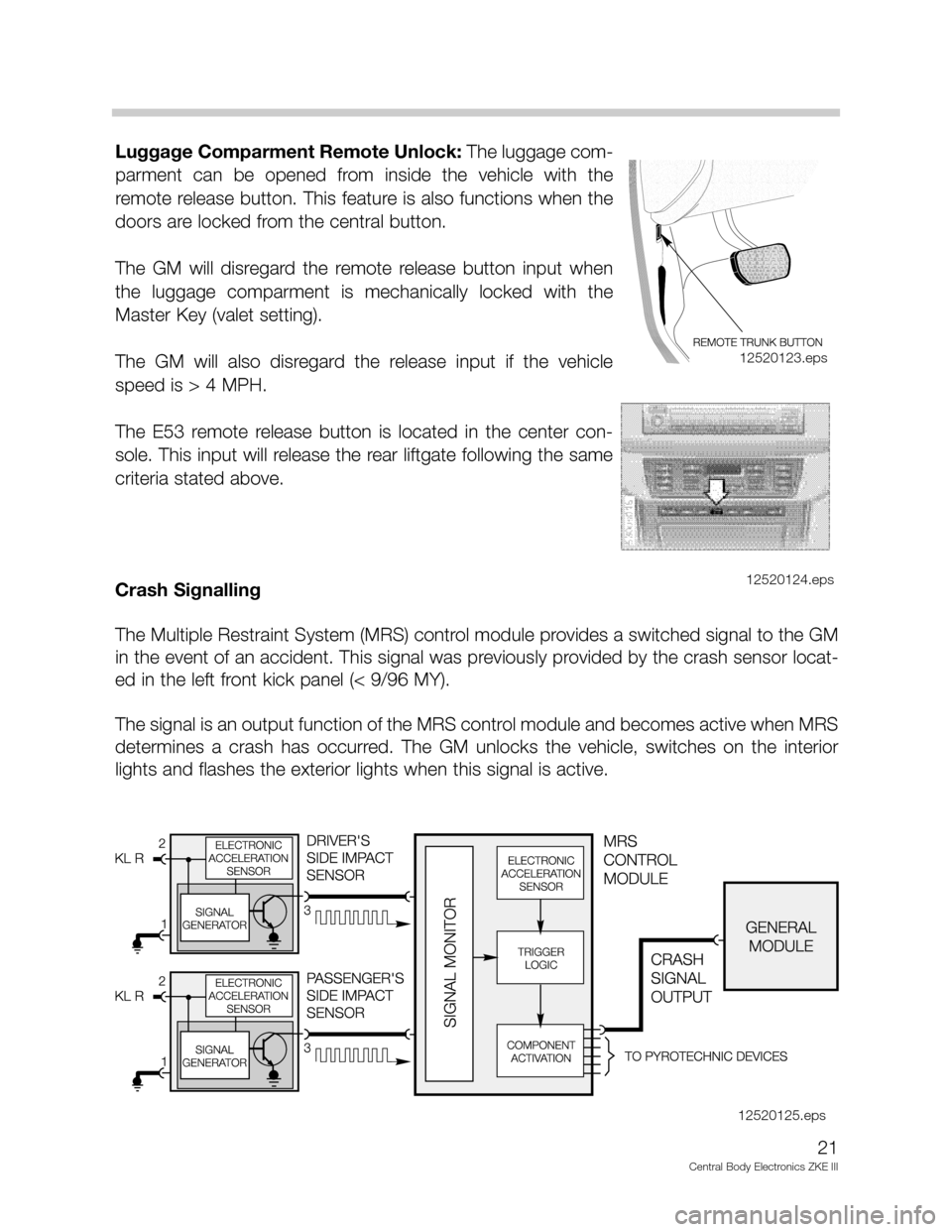
Luggage Comparment Remote Unlock: The luggage com-
parment can be opened from inside the vehicle with the
remote release button. This feature is also functions when the
doors are locked from the central button.
The GM will disregard the remote release button input when
the luggage comparment is mechanically locked with the
Master Key (valet setting).
The GM will also disregard the release input if the vehicle
speed is > 4 MPH.
The E53 remote release button is located in the center con-
sole. This input will release the rear liftgate following the same
criteria stated above.
Crash Signalling
The Multiple Restraint System (MRS) control module provides a switched signal to the GM
in the event of an accident. This signal was previously provided by the crash sensor locat-
ed in the left front kick panel (< 9/96 MY).
The signal is an output function of the MRS control module and becomes active when MRS
determines a crash has occurred. The GM unlocks the vehicle, switches on the interior
lights and flashes the exterior lights when this signal is active.
21
Central Body Electronics ZKE III
12520123.eps
12520124.eps
12520125.eps
Page 22 of 80
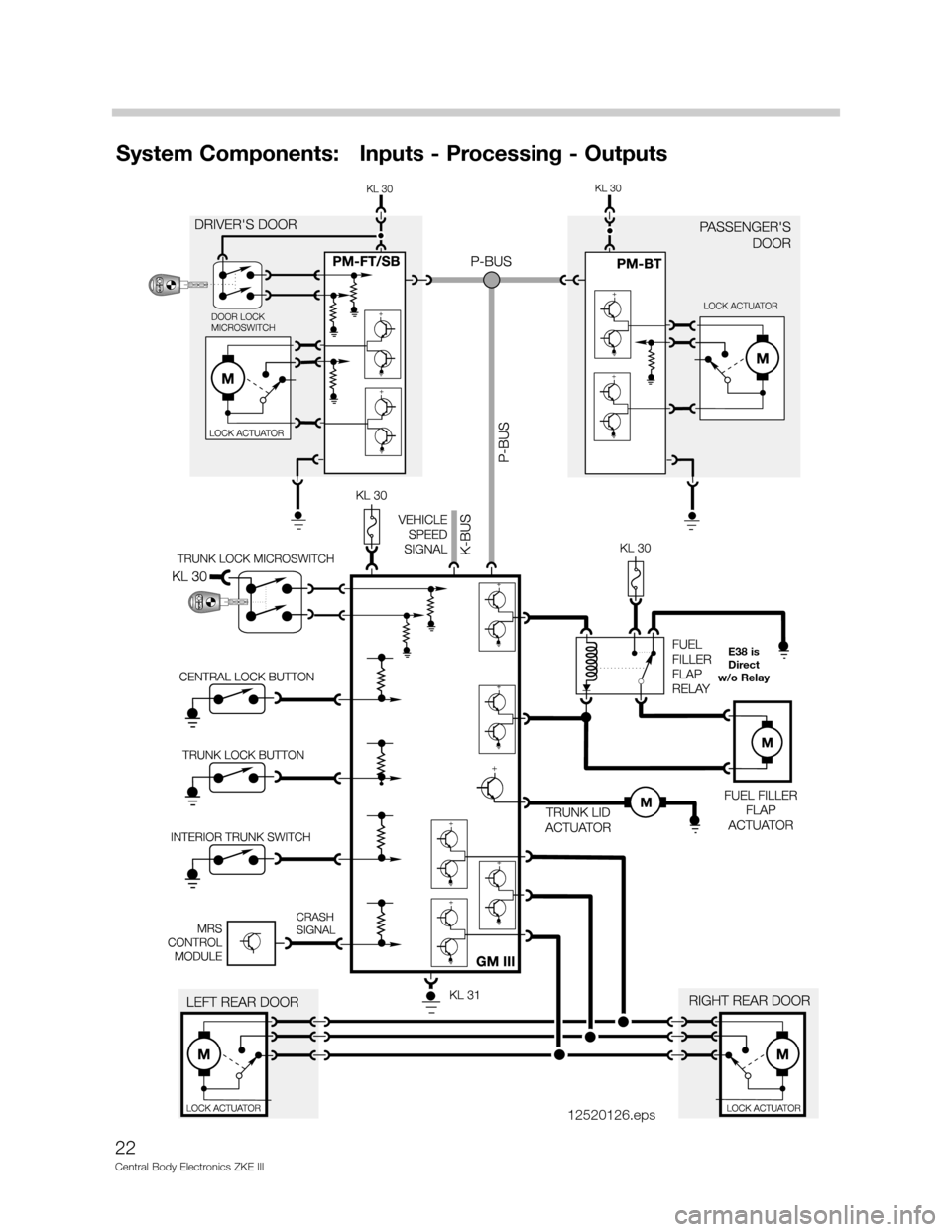
22
Central Body Electronics ZKE III
System Components: Inputs - Processing - Outputs
12520126.eps
E38 is
Direct
w/o Relay
Page 23 of 80
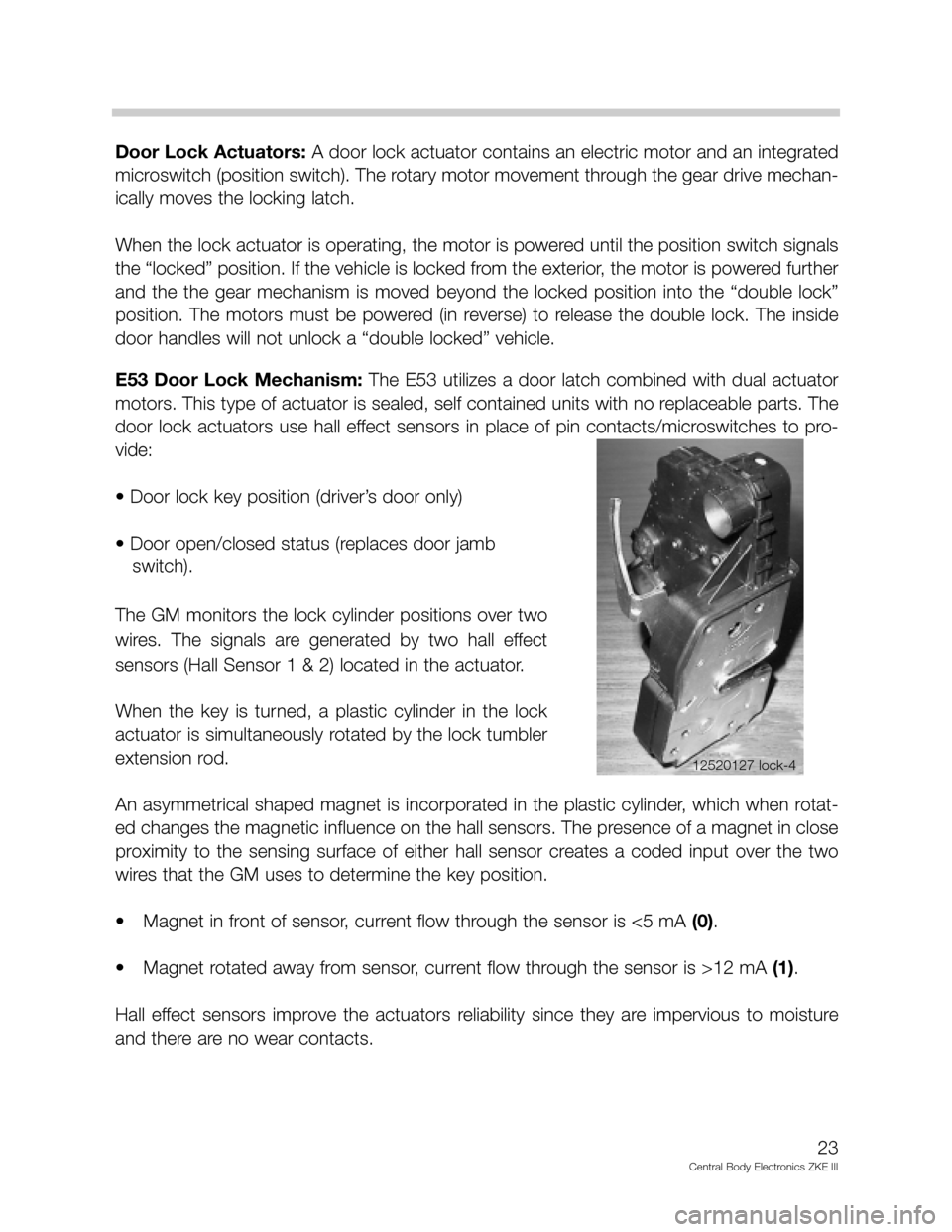
Door Lock Actuators: A door lock actuator contains an electric motor and an integrated
microswitch (position switch). The rotary motor movement through the gear drive mechan-
ically moves the locking latch.
When the lock actuator is operating, the motor is powered until the position switch signals
the “locked” position. If the vehicle is locked from the exterior, the motor is powered further
and the the gear mechanism is moved beyond the locked position into the “double lock”
position. The motors must be powered (in reverse) to release the double lock. The inside
door handles will not unlock a “double locked” vehicle.
E53 Door Lock Mechanism: The E53 utilizes a door latch combined with dual actuator
motors. This type of actuator is sealed, self contained units with no replaceable parts. The
door lock actuators use hall effect sensors in place of pin contacts/microswitches to pro-
vide:
• Door lock key position (driver’s door only)
• Door open/closed status (replaces door jamb
switch).
The GM monitors the lock cylinder positions over two
wires. The signals are generated by two hall effect
sensors (Hall Sensor 1 & 2) located in the actuator.
When the key is turned, a plastic cylinder in the lock
actuator is simultaneously rotated by the lock tumbler
extension rod.
An asymmetrical shaped magnet is incorporated in the plastic cylinder, which when rotat-
ed changes the magnetic influence on the hall sensors. The presence of a magnet in close
proximity to the sensing surface of either hall sensor creates a coded input over the two
wires that the GM uses to determine the key position.
• Magnet in front of sensor, current flow through the sensor is <5 mA (0).
• Magnet rotated away from sensor, current flow through the sensor is >12 mA (1).
Hall effect sensors improve the actuators reliability since they are impervious to moisture
and there are no wear contacts.
23
Central Body Electronics ZKE III
12520127 lock-4
Page 24 of 80
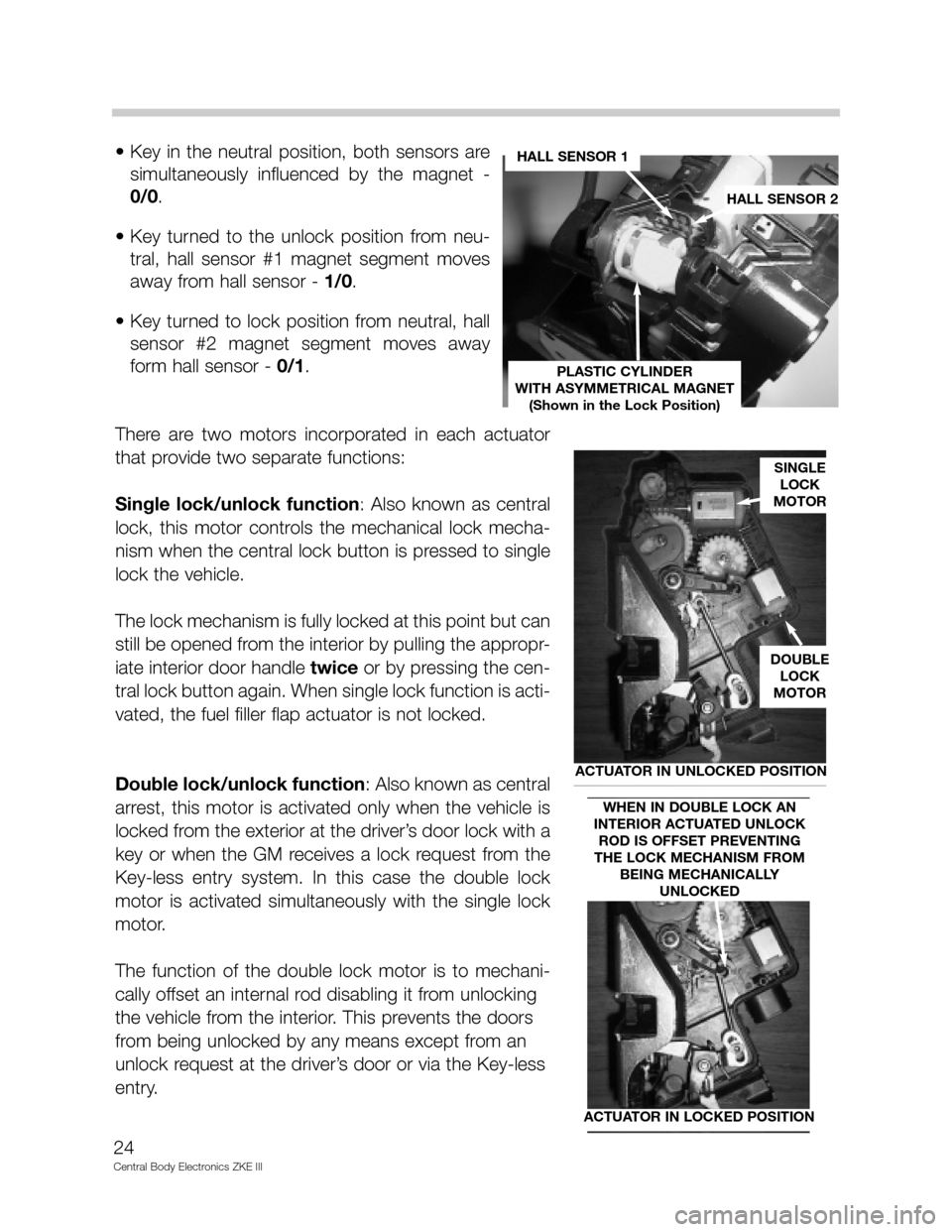
• Key in the neutral position, both sensors are
simultaneously influenced by the magnet -
0/0.
• Key turned to the unlock position from neu-
tral, hall sensor #1 magnet segment moves
away from hall sensor - 1/0.
• Key turned to lock position from neutral, hall
sensor #2 magnet segment moves away
form hall sensor - 0/1.
There are two motors incorporated in each actuator
that provide two separate functions:
Single lock/unlock function: Also known as central
lock, this motor controls the mechanical lock mecha-
nism when the central lock button is pressed to single
lock the vehicle.
The lock mechanism is fully locked at this point but can
still be opened from the interior by pulling the appropr-
iate interior door handle twice or by pressing the cen-
tral lock button again. When single lock function is acti-
vated, the fuel filler flap actuator is not locked.
Double lock/unlock function: Also known as central
arrest, this motor is activated only when the vehicle is
locked from the exterior at the driver’s door lock with a
key or when the GM receives a lock request from the
Key-less entry system. In this case the double lock
motor is activated simultaneously with the single lock
motor.
The function of the double lock motor is to mechani-
cally offset an internal rod disabling it from unlocking
the vehicle from the interior. This prevents the doors
from being unlocked by any means except from an
unlock request at the driver’s door or via the Key-less
entry.
24
Central Body Electronics ZKE III
HALL SENSOR 1
HALL SENSOR 2
PLASTIC CYLINDER
WITH ASYMMETRICAL MAGNET
(Shown in the Lock Position)
SINGLE
LOCK
MOTOR
DOUBLE
LOCK
MOTOR
ACTUATOR IN UNLOCKED POSITION
ACTUATOR IN LOCKED POSITION
WHEN IN DOUBLE LOCK AN
INTERIOR ACTUATED UNLOCK
ROD IS OFFSET PREVENTING
THE LOCK MECHANISM FROM
BEING MECHANICALLY
UNLOCKED
Page 25 of 80
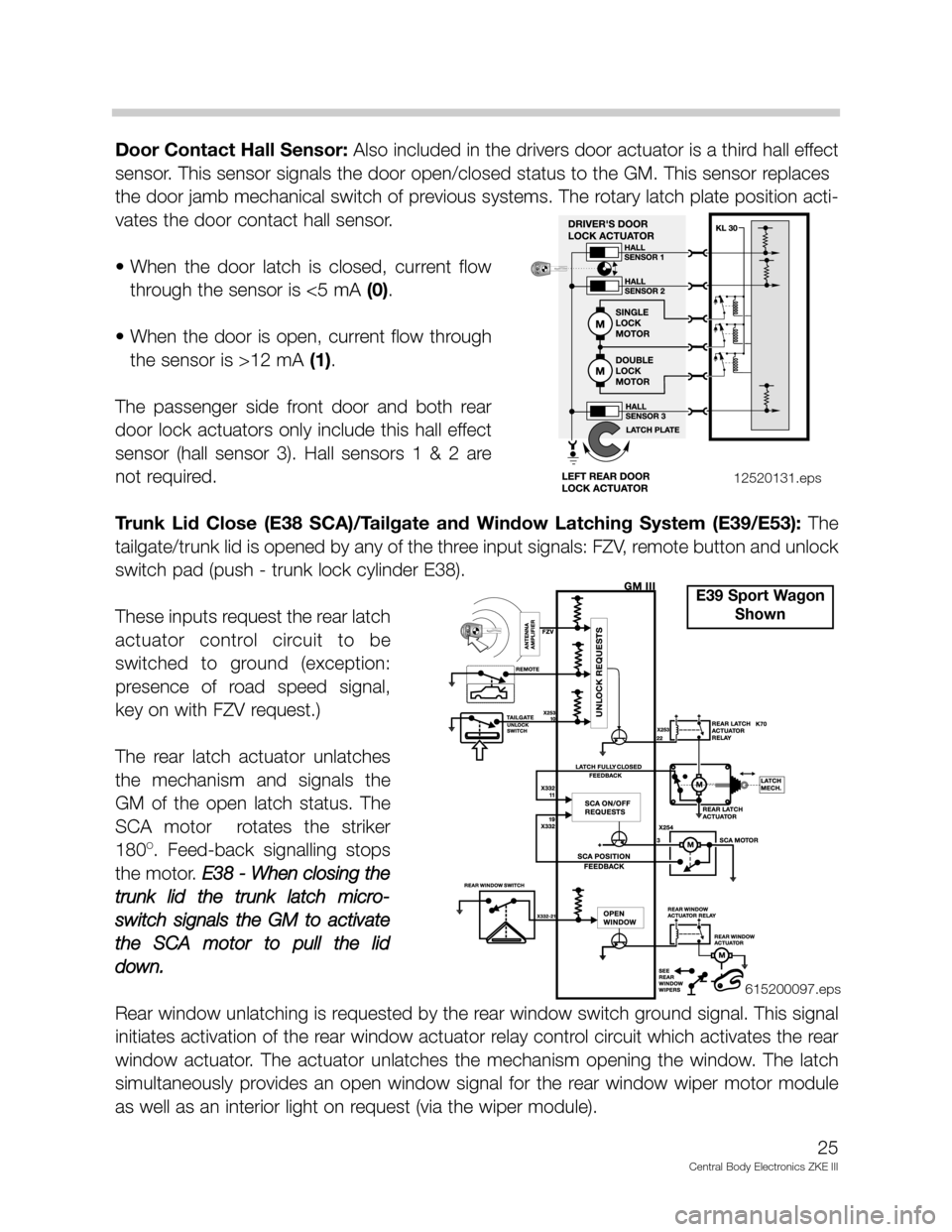
Door Contact Hall Sensor: Also included in the drivers door actuator is a third hall effect
sensor. This sensor signals the door open/closed status to the GM. This sensor replaces
the door jamb mechanical switch of previous systems. The rotary latch plate position acti-
vates the door contact hall sensor.
• When the door latch is closed, current flow
through the sensor is <5 mA (0).
• When the door is open, current flow through
the sensor is >12 mA (1).
The passenger side front door and both rear
door lock actuators only include this hall effect
sensor (hall sensor 3). Hall sensors 1 & 2 are
not required.
Trunk Lid Close (E38 SCA)/Tailgate and Window Latching System (E39/E53): The
tailgate/trunk lid is opened by any of the three input signals: FZV, remote button and unlock
switch pad (push - trunk lock cylinder E38).
These inputs request the rear latch
actuator control circuit to be
switched to ground (exception:
presence of road speed signal,
key on with FZV request.)
The rear latch actuator unlatches
the mechanism and signals the
GM of the open latch status. The
SCA motor rotates the striker
180
O. Feed-back signalling stops
the motor. E38 - When closing the
trunk lid the trunk latch micro-
switch signals the GM to activate
the SCA motor to pull the lid
down.
Rear window unlatching is requested by the rear window switch ground signal. This signal
initiates activation of the rear window actuator relay control circuit which activates the rear
window actuator. The actuator unlatches the mechanism opening the window. The latch
simultaneously provides an open window signal for the rear window wiper motor module
as well as an interior light on request (via the wiper module).
25
Central Body Electronics ZKE III
12520131.eps
E39 Sport Wagon
Shown
615200097.eps
Page 26 of 80
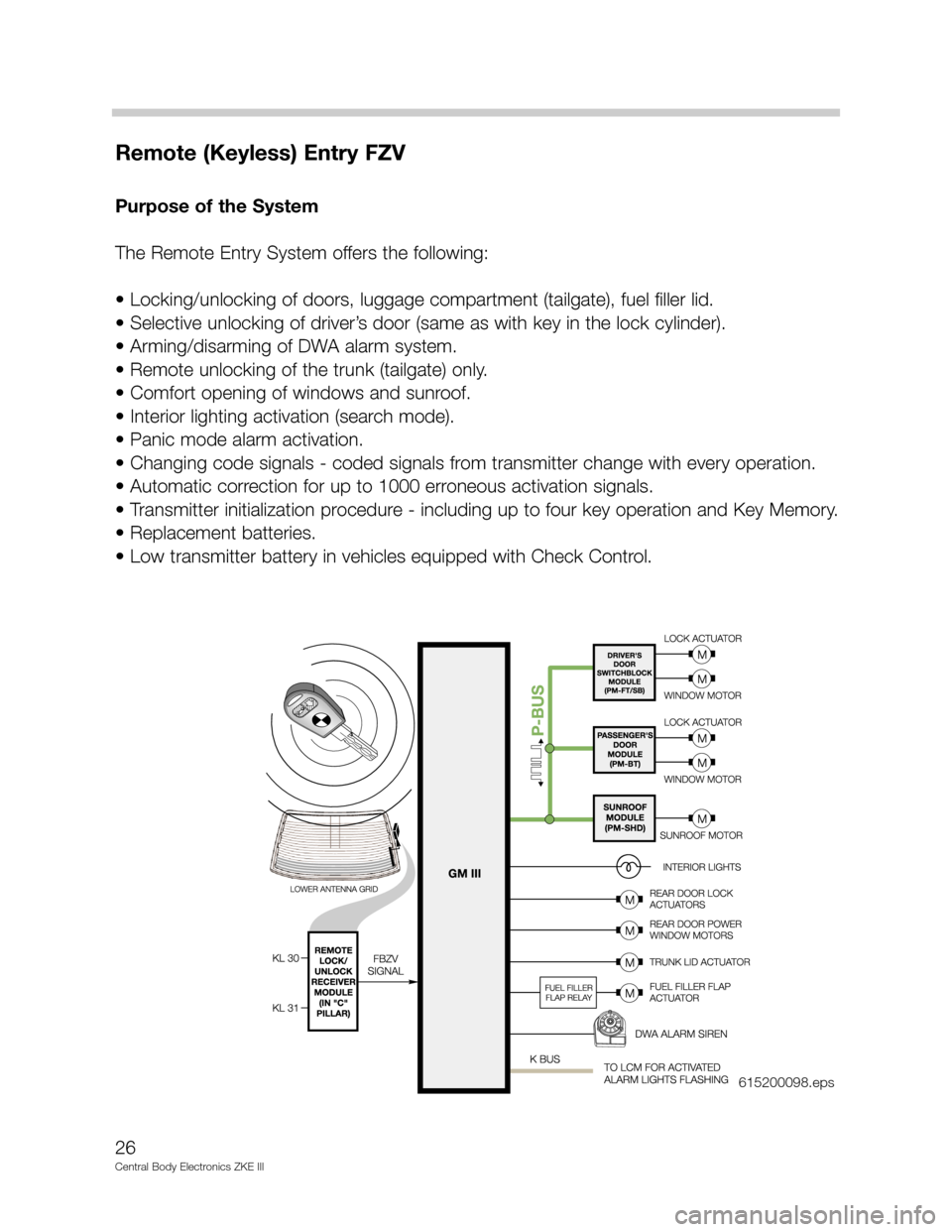
Remote (Keyless) Entry FZV
Purpose of the System
The Remote Entry System offers the following:
• Locking/unlocking of doors, luggage compartment (tailgate), fuel filler lid.
• Selective unlocking of driver’s door (same as with key in the lock cylinder).
• Arming/disarming of DWA alarm system.
• Remote unlocking of the trunk (tailgate) only.
• Comfort opening of windows and sunroof.
• Interior lighting activation (search mode).
• Panic mode alarm activation.
• Changing code signals - coded signals from transmitter change with every operation.
• Automatic correction for up to 1000 erroneous activation signals.
• Transmitter initialization procedure - including up to four key operation and Key Memory.
• Replacement batteries.
• Low transmitter battery in vehicles equipped with Check Control.
26
Central Body Electronics ZKE III
615200098.eps
Page 27 of 80
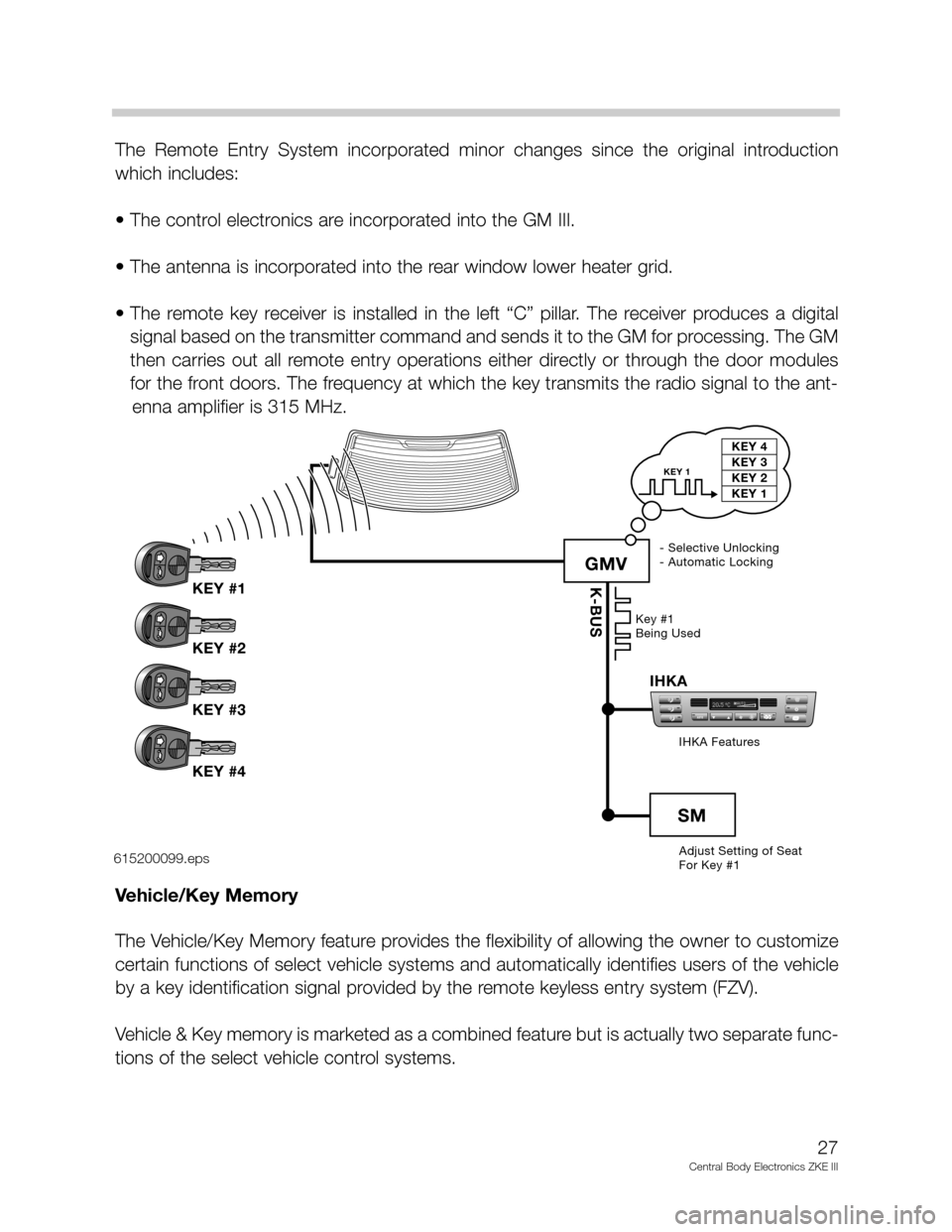
The Remote Entry System incorporated minor changes since the original introduction
which includes:
• The control electronics are incorporated into the GM III.
• The antenna is incorporated into the rear window lower heater grid.
• The remote key receiver is installed in the left “C” pillar. The receiver produces a digital
signal based on the transmitter command and sends it to the GM for processing. The GM
then carries out all remote entry operations either directly or through the door modules
for the front doors. The frequency at which the key transmits the radio signal to the ant-
enna amplifier is 315 MHz.
Vehicle/Key Memory
The Vehicle/Key Memory feature provides the flexibility of allowing the owner to customize
certain functions of select vehicle systems and automatically identifies users of the vehicle
by a key identification signal provided by the remote keyless entry system (FZV).
Vehicle & Key memory is marketed as a combined feature but is actually two separate func-
tions of the select vehicle control systems.
27
Central Body Electronics ZKE III
A
IHKA
K-BUSKEY #1
KEY #2
KEY #3
KEY #4
GMV
SM
Adjust Setting of Seat
For Key #1 IHKA Features Key #1
Being Used
KEY 4
KEY 3
KEY 2
KEY 1
KEY 1
- Selective Unlocking
- Automatic Locking
615200099.eps
Page 28 of 80

Vehicle Memory: The owner is provided with a list of available system functions that can
be customized to their liking. Prior to delivery, the DISplus or MoDiC is used to encode the
owner’s chosen selections into the appropriate control modules.
These choices become a permanent function of the control module and can only be
changed by re-encoding with the DISplus or MoDiC at a BMW Center.
This feature has been available for some time via the ZCS Conversion Feature but has
never been fully utilized or officially presented to the vehicle owner as a feature of their vehi-
cle.
Key Memory: This feature provides the added convenience of identifying users of the vehi-
cle whenever a lock or unlocked signal is generated via the individual FZV keys. A maxi-
mum of four FZV keys can be used with the Key Memory feature.
Each of the four keys generate a unique key identification signal (key number) that is trans-
mitted simultaneously with the lock/unlock signals to the General Module. Key Memory
does not respond to Lock/Unlock requests from the drivers door lock.
Mostof the key memory functions require the vehicle be configured using the “KEY MEM-
ORY” function of the DIS or MoDiC. However, there are a few features that store settings
automatically without configuration such as IHKA blower speed and temp setting. The key
ID signal alerts the GM to communicate with select control systems over the K Bus to store
(when locked) or reset (when unlocked) certain driver adjustable settings.
There are features that function as both a Car & Key Memory feature.
Example; the Automatic Seat Adjustment feature is encoded as a Car Memory Function
with the following possibilities:
• When unlocking,
• When opening a door after unlocking
• Or not active at all.
If active, the seat positions are stored and reactivated by the Key Memory function for indi-
vidual users of the car.
Notes: _______________________________________________________________________
_____________________________________________________________________________
_____________________________________________________________________________
_____________________________________________________________________________
_____________________________________________________________________________
28
Central Body Electronics ZKE III
Page 29 of 80
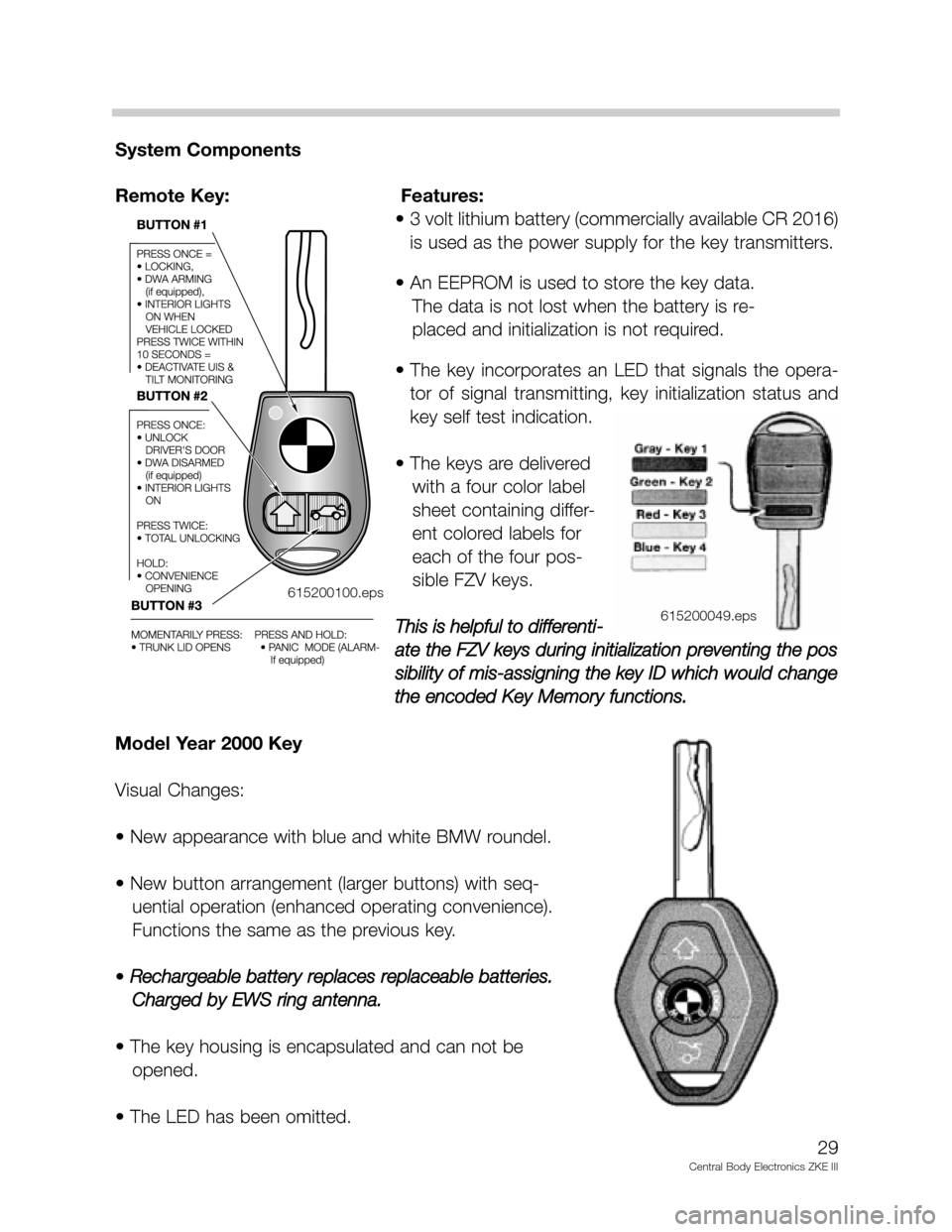
System Components
Remote Key: Features:
• 3 volt lithium battery (commercially available CR 2016)
is used as the power supply for the key transmitters.
• An EEPROM is used to store the key data.
The data is not lost when the battery is re-
placed and initialization is not required.
• The key incorporates an LED that signals the opera-
tor of signal transmitting, key initialization status and
key self test indication.
• The keys are delivered
with a four color label
sheet containing differ-
ent colored labels for
each of the four pos-
sible FZV keys.
This is helpful to differenti-
ate the FZV keys during initialization preventing the pos
sibility of mis-assigning the key ID which would change
the encoded Key Memory functions.
Model Year 2000 Key
Visual Changes:
• New appearance with blue and white BMW roundel.
• New button arrangement (larger buttons) with seq-
uential operation (enhanced operating convenience).
Functions the same as the previous key.
• Rechargeable battery replaces replaceable batteries.
Charged by EWS ring antenna.
• The key housing is encapsulated and can not be
opened.
• The LED has been omitted.
29
Central Body Electronics ZKE III
615200049.eps 615200100.eps
Page 30 of 80
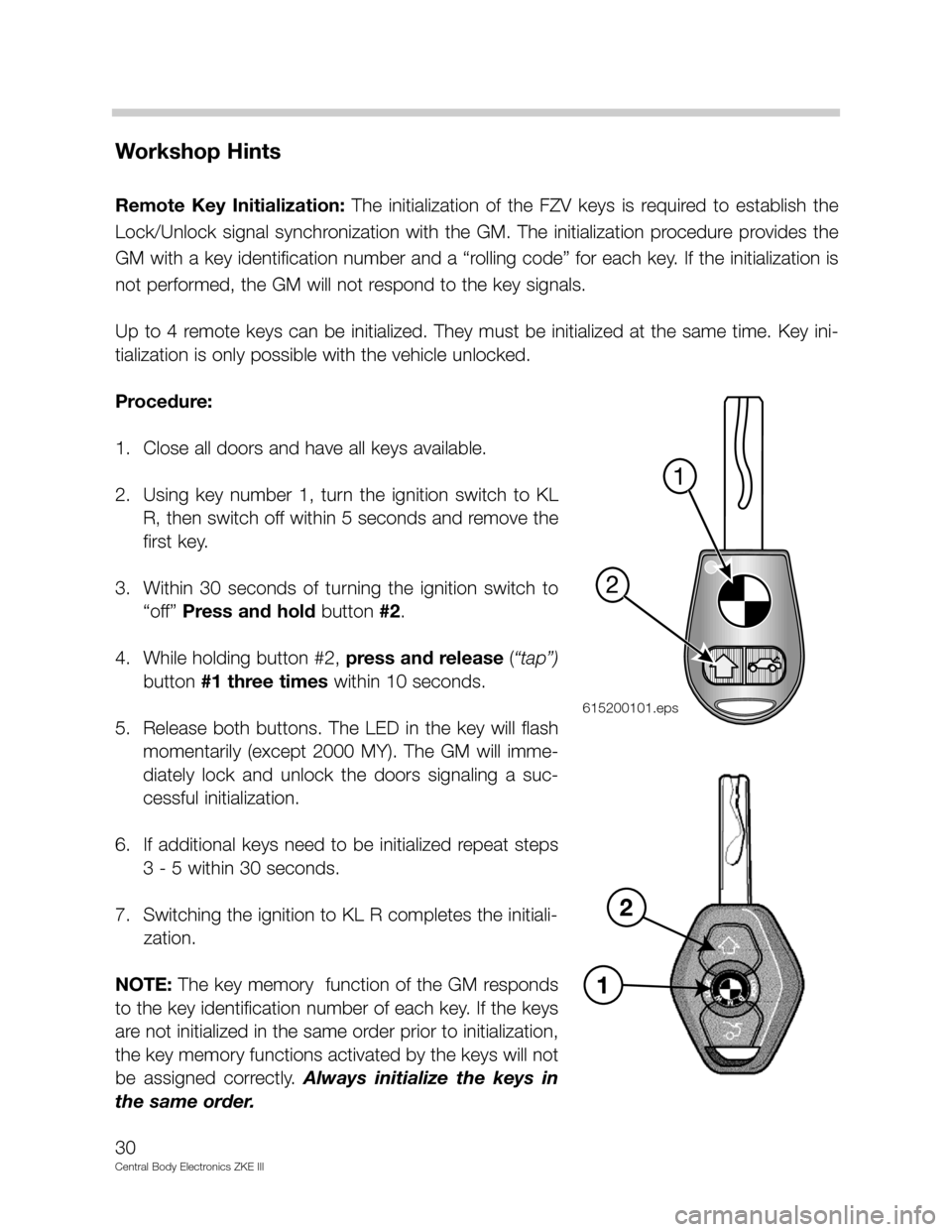
Workshop Hints
Remote Key Initialization: The initialization of the FZV keys is required to establish the
Lock/Unlock signal synchronization with the GM. The initialization procedure provides the
GM with a key identification number and a “rolling code” for each key. If the initialization is
not performed, the GM will not respond to the key signals.
Up to 4 remote keys can be initialized. They must be initialized at the same time. Key ini-
tialization is only possible with the vehicle unlocked.
Procedure:
1. Close all doors and have all keys available.
2. Using key number 1, turn the ignition switch to KL
R, then switch off within 5 seconds and remove the
first key.
3. Within 30 seconds of turning the ignition switch to
“off” Press and holdbutton #2.
4. While holding button #2, press and release(“tap”)
button #1 three timeswithin 10 seconds.
5. Release both buttons. The LED in the key will flash
momentarily (except 2000 MY). The GM will imme-
diately lock and unlock the doors signaling a suc-
cessful initialization.
6. If additional keys need to be initialized repeat steps
3 - 5 within 30 seconds.
7. Switching the ignition to KL R completes the initiali-
zation.
NOTE: The key memory function of the GM responds
to the key identification number of each key. If the keys
are not initialized in the same order prior to initialization,
the key memory functions activated by the keys will not
be assigned correctly. Always initialize the keys in
the same order.
30
Central Body Electronics ZKE III
1
2
615200101.eps